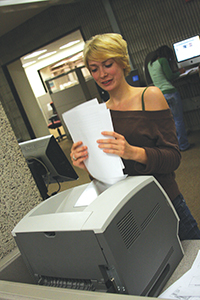
Throughout the 2008-09 academic year, Binghamton University printed over 10 million pieces of paper. Without a monetary incentive for students to print less, some officials worry that the University’s paper use will continue to skyrocket.
According to James L. Wolf, director of Academic Computing Services, as faculty have made more course materials available electronically, it is easier now than ever before for students to access and print assignments.
In the place of the traditional textbook, many classes use electronic journals that students may be required to print out and bring to class.
“One thing that concerned me was that our income from overflow printing last year was three times more than the previous year,” Wolf said.
This semester, BU is using 10 percent more paper than it used last fall.
BU students are provided with a weekly printing quota that is included with tuition.
The student printing quota was converted one year ago from a page limit to a monetary limit, Wolf said.
“The way printing quota works is that you start every semester with a basic amount and each week after that it is incremented by $2, at 5 cents a page,” he said. “If you go through the week and no longer have quota, you can charge your BUC$ card for overflow printing.”
According to Wolf, the overuse of paper is “an issue that needs to be developed and addressed through behavioral modification, rather than administrators cutting quotas or raising prices.”
Approximately 40 to 50 percent of printing is done on the duplex printers, which were installed last year. Duplex printers not only save paper, but they are 2 cents cheaper per side than single-sided printing.
Student groups such as New York Public Interest Research Group (NYPIRG), Engineers without Borders and Student Environmental Action Coalition are working on campaigns to raise awareness of the printing statistics and present students and faculty with alternatives.
NYPIRG has placed collection boxes next to the printers for spare paper that they plan to recycle into notebooks for students.
Vikram S. Arjunwadkar, a graduate student in industrial engineering and a help desk consultant at the Bartle PODS, said he reloads every printer each hour.
“Every hour, I use four stacks of paper that each contain 500 pages,” he said.
Dave Vose, a librarian and information commons coordinator, said that for several years the library has invested in electronic databases of academic journals to which students have free access.
The library has been promoting the slogan, “What goes online, stays online,” emphasizing that electronic materials are more portable than print copies.
Additionally, the library uses ILLiad Interlibrary Loan, which provides students with access to electronic articles from other libraries.
“Students should be making more use of their H drive for storing articles,” he said. “Every student has a certain amount of network storage they can access anywhere in the world through ssl.binghamton.edu.”
According to Vose, if students saved assignments or journals to their H drive, the amount of printing would decrease.
“I think right now there aren’t any disincentives to printing,” he said. “You’re given many pages, money rolls over, the information commons are open 24 hours. The fact that we provide free printing is not unusual, but there are schools that are not nearly as generous as we are.”
Vose said that BU tour guides often emphasize the free printing perk to prospective students, instilling them with a sense of expectation and entitlement.
Additionally, he thinks the environment becomes a secondary consideration when printing is a necessity.
“We need to walk the walk of a ‘green campus,’” he said.


